
Tabora was, as noted by Henry Stanley in his book "How I found Stanley", the slave capital of central Africa.
He talks of the great wealth of the Arab slave traders who lived there and who rounded up Africans like cattle and drove them to Bagamoyo near Dar-es-Salaam before they were taken overseas to be sold on the four corners of the earth.
In the maps below you will see a scan of Stanley's map of Livingstone drawn in 1869, and a recent satelite image of the same part of Tabora showing the locations of two prominent landmarks noted on Stanley's work (the Sultan's Temple and the village) and the railway line where the Tabora Pound was minted.
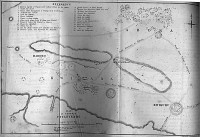 |
|
Stanley's 1869 map of Tabora |
Satelite scan of modern day Tabora |
Commercial banking was introduced in German East Africa in 1905, when the Deutsch-Ostafrikanische Bank opened its office in Dar es Salaam. This bank had a concession from the German Government to issue its own notes and coins, which helped the bank to meet the demand for coins in exchange for its notes. In 1911, another German bank, the Handelsbank fuer Ostafrika, opened a branch in Tanga. Then came the first world war.
The "Tabora Pound", a gold coin valued at 15 Rupees, was designed by mining industry expert Friedrich Schumacher at Tabora and weighs 6.8 gram (gold). It was minted in a temporary siege-mint by the Deutsch-Ostafrikanische Bank in an adapted train carriage at Tabora in 1916 following the fall of Germany's major port, Dar-es-Salaam, to the Allies during World War One. Tabora (thus the letter "T" under the date) was the centre of the Arab slave trade in the 1800s at the time of Livingstone and Stanley. The steam from the train to which the "mint carriage" was attached drove a palm oil press that was used to mint these unique high quality gold pieces. A less sophisticated minting device was used in Tabora to produce the brass 5 and 20 Heller coins. The Tabora Pound is, without doubt, the most beautiful wartime siege currency ever minted.
The gold coins were needed to pay the native troops, for, as in South Africa they, wisely, did not trust paper bank notes. Vorbeck's goal was to give one of these gold coins to each member of this 15,000 native askari army. The minting was possible because of a small gold mine in operation not very far away from Tabora from which the gold used in the coins was mined.
The coin features the king of the beasts, a triumphant elephant, trumpeting with Mount Kilimanjaro in the background and the date “1916 T” below, a Singhalese gold worker from Zanzibar made the dies after a model prepared by R. Vogt. The reverse features the German imperial eagle with the legend “Deutsch Ost Afrika” and the denomination of 15 Rupien. There are two varieties which can best be distinguished by the arabesque extending from the right wing of the German eagle. In the slightly rarer first variety, "type A", it ends under the “A” in “Afrika” (mintage 6,395), and in the second variety "type B", it ends under the “T” in “Ost” (mintage about 9,035). Due to the primitive nature of the conditions under which the coins were struck, the gold was a reddish gold, containing copper and silver, since these metals could not be refined out of the gold.
Soon after their minting Tabora was occupied by allies' Belgian troops. Indian traders asked 200 rupies each for these coins - like the Veld Pond they were considered rare from the very beginning. Today the 15 Rupee gold coin coin fetches several thousand US dollars for a circulated one and much more for one in Unc. The price of these pieces has already risen by several hundred percent since 2000 and in late 2005 coins were being offered for sale for E10,000.
| Hi There
I read your article about the Tabora pound. Found it interesting. As I understood from my father many years ago, this tabora pound was also used to pay Germans who worked on the railwayline. An uncle of my father who was a sea captain of a ship from Germany was paid with that money, I think he was a prisonar of war. He was working for the German Merchant Navy. He was quite a character and his name was Walter Herm. I inherited one of those golden coins (Tabora Pound). My great uncle's grand daughter also inherited a Tabora pound. Regards Elsbeth |
Few of the coins actually went into general circulation, which in any account, would not have been longer than a couple of months when the Allies closed in on Tabora. Many of the coins were captured by the Allies when they finally took Tabora and these were either melted down or taken as war souvenirs by them - which accounts for the large number of pieces that remain in good condition (Extra Fine or, occasionally, almost Uncirculated and rarely Unc).
It is a classical siege coin but reflects the German's innovation and demand for quality. When one compares the outcome with the earlier siege boer (S African gold Veld Pond, struck under much more difficult and trying conditions in the dying days of Afrikaaner independence, you can see why this 15 Rupien Gold coin has also become such a classic rarity. The detail is exquisite and design totally unique with the African symbol of power, the elephant, charging down its foes with complete abandon - a symbol flying in the face of the reality facing the Germans at that time. In the images of the two coins held by the Balson Holdings Family Trust you can see how the dies slowly degrade and, in the lower coin, the edges in particular start losing their crispness with the beads along the border disappearing. If this was a series of bank notes the top coin would be among the first struck (A series) and the bottom coin reflecting maybe a (G - or much later printing - Series). This piece in both its varieties is a "chariot" - ie great short term investment.
Not long after it was struck the German army under von Lettow Vorbeck retreated south from the Allies and so began an amazing and historic game of wild goose chase - one that the Allies never won.
The Balson Holdings Family Trust owns two type "B" 15 Rupien pieces
- displayed below.
This coin below was purchased by the Balson Holdings Family
Trust from Heritage Coins in June 2005 (Item 13154) they noted:
"lustrous AU and about as nice as we have seen one of these pieces".
This piece is about as good as the "Tabora Pound", under siege conditions,
gets. Value over US$4,000.
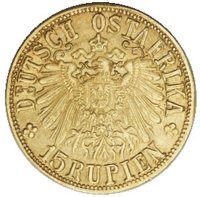 |
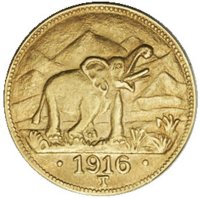 |
This coin below, almost UNC for the series, is owned by the Balson Holdings Family Trust. It reflects the deterioration of the dies over time - in particular on the side of the elephant - see rim bottom right area and the rim bordering the eagle at 6 and 9 o'clock. Value over US$3,000.
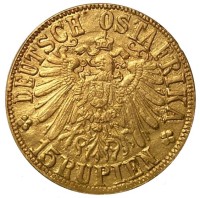 |
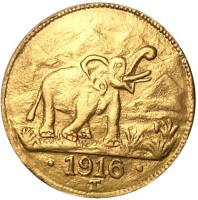 |
Value in 2006: The 1916 Tabora Pound is highly sought after - now being sold for up to 10,000 Euro in Germany. Rarely seen on auction.
[Brief history of German East Africa]
[1915 Interim Bank Notes] [The
20 Heller "gun metal" coin struck in 1916]
[1916 15 Rupee "Tabora Pound" Gold Coin]
[1917 Interim Bank Notes - struck in the field]
[von Lettow-Vorbeck an extraordinary soldier]
[Vorbeck's Despairing Post Card]
[Rare German East Africa Siege Coins, Notes and
Collectables] [Web Site Text Site Map]
[Tokencoins.com Home Page]